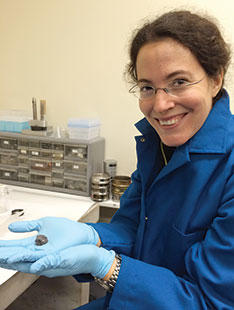Geosciences: Space Age
New research dating the moon reveals it, and Earth, to be much older than thought
The Earth as we know it was formed billions of years ago, when a proto-Earth crashed into a Mars-sized planet known as Theia. The explosion created a hot mess of rock and magma that eventually came together to form the moon. What was left of the proto-Earth, together with material from Theia, became our planet. For a long time, scientists have struggled to guess exactly when this cataclysmic event occurred. According to Blair Schoene, associate professor of geosciences, “There is nothing on Earth that is the age of the Earth,” since wind, water, and plate tectonics have long since recycled any material from the original proto-Earth.
The moon presents a different challenge. Even though the rocks there have remained relatively undisturbed, they took their time to form from a vast ocean of magma that no longer exists. Now, a former postdoctoral researcher in Schoene’s lab, Melanie Barboni, has determined the age of crystals derived from that magma and the time when the moon first formed. The results reveal it — and Earth as we know it — to be much older than scientists thought.

Barboni worked backward in a two-step process. The first part of the process was with Schoene at Princeton, where they dated the age of zircon crystals in moon rocks collected by Apollo 14 astronauts. Barboni, who is now an assistant researcher at UCLA, and Schoene subjected the rocks to a technique called isotope dilution thermal ionization mass spectrometry, a high-precision technique to determine the amounts of uranium and lead isotopes.
Unlike traditional mass spectrometry, the process destroys small quantities of the crystals; however, results are 10 to 100 times more accurate than other methods. The researchers dissolved tiny grains of rock, about the width of a strand of hair, in acid, then ionized them by placing them on a 1,400-degree-celsius filament. “We can have this very stable ion beam [that] sits there for hours, and we can measure it over and over,” says Schoene. Since uranium degrades to lead isotopes at a known rate, the researchers could accurately measure the age of the rocks by measuring the relative quantities of each.
The moon formed less than 60 million years into the formation of our solar system, providing an important reference point for astronomers hoping to understand how Earth and other planetary bodies formed.
For the second part of the experiment, performed at UCLA, Barboni measured the proportions of the element lutetium and isotopes of hafnium to determine when the crystals themselves formed from the magma. Together, the two processes determined the age of the moon to be at least 4.51 billion years old. That is 40 million to 140 million years older than previously thought, Barboni and Schoene wrote in a paper published with other colleagues in Science Advances in January.
The paper also notes that the moon formed less than 60 million years into the formation of our solar system, providing an important reference point for astronomers hoping to understand how Earth and other planetary bodies formed. “Knowing the age of the moon also, in a way, tells you the age of the Earth,” says Schoene, “since this giant impact was time zero, even if parts of it were present before that.” In addition, he says, knowing the approximate date of this birthday can help geoscientists determine the chemical composition of both the moon and Earth, providing new insight about not only our celestial neighbor, but also the planet we call home.












No responses yet